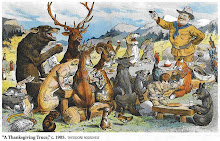Studies try to get handle on coyotes in N.C.
Posted to: News North Carolina
Currituck County, N.C.
North Carolina wildlife biologist Colleen Olfenbuttel was driving in Pender County on Interstate 40 last Sunday afternoon when a coyote came out of the woods, looked to one side and then to the other, waited for a couple of cars to pass, and then crossed the road.
"We went by and he went across right behind us," she said. "Most animals bolt."
Coyotes are the only animal she knows that looks both ways before crossing the road, said Olfenbuttel, who specializes in bear and furbearing animals for the North Carolina Wildlife Resources Commission.
Four different studies are either under way or soon will be to discover more about coyotes, including two studies in parts of Hyde, Dare, Washington and Tyrrell counties.
"There is a lot of interest," Olfenbuttel said. "They are the most successful animal and most adaptable in North Carolina."
Typically perceived as western animals, coyotes began appearing in North Carolina in the 1930s, but most of those were animals brought here for hunting.
Coyotes also began migrating here naturally in larger numbers by the early 1990s and were established statewide in 2005, Olfenbuttel said.
Coyotes are hard to trap, difficult to hunt, and adaptable to most any environment, whether it be forests, swamps, the coast, rural, urban or suburban.
If coyote numbers fall from disease or hunting, they have larger litters to make up for it. If one catches a whiff of a hunter in the wind, it will disappear for a while. If a trap misses, then that coyote will likely never be caught in a trap.
They really are wily coyotes.
"Coyotes are opportunistic," Olfenbuttel said. "They learn quickly."
The jury is out on what effect the growing number of coyotes is having. Population counts are not available, but coyotes are known to exist in all 100 counties in the state, she said.
At least one report says coyotes could be responsible for declines in deer population in the southeastern United States.
That is not the case in North Carolina, said Chris Turner, a state wildlife biologist in northeastern North Carolina. Deer herds are generally healthy.
"Only time will tell," he said. "Coyotes are not strong deer predators. They eat lots of things."
Research on the scat, or waste, of one coyote showed it practically lived on grasshoppers. Mice, rabbits, bugs, garbage and pet food are also on the menu.
Coyotes have been known to take pets and small livestock. Attacks on people happen when coyotes either have rabies or have been fed by humans and lost their fear of them, Olfenbuttel said. There are no reports of coyotes attacking people in North Carolina.
Hunting season is open year round for coyotes, which helps them maintain a healthy fear of humans and reduces conflicts, Olfenbuttel said.











No comments:
Post a Comment